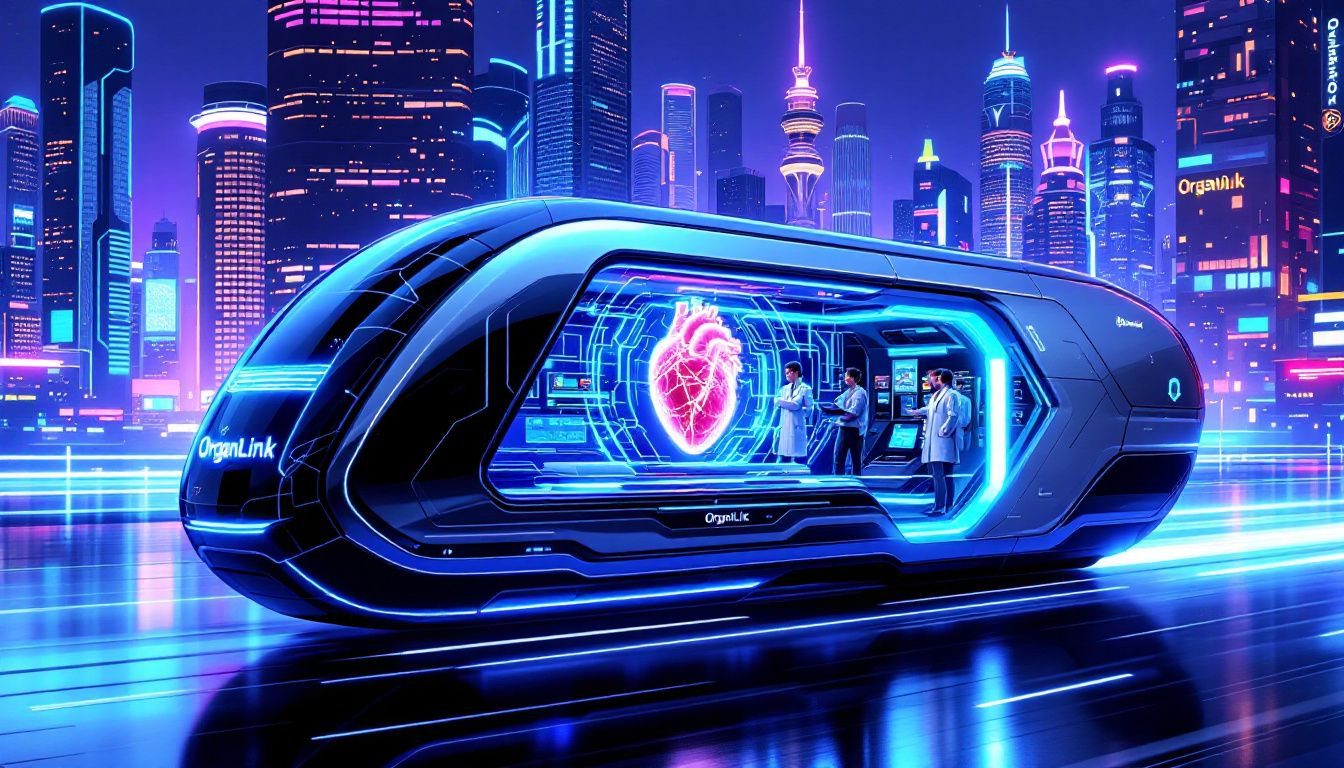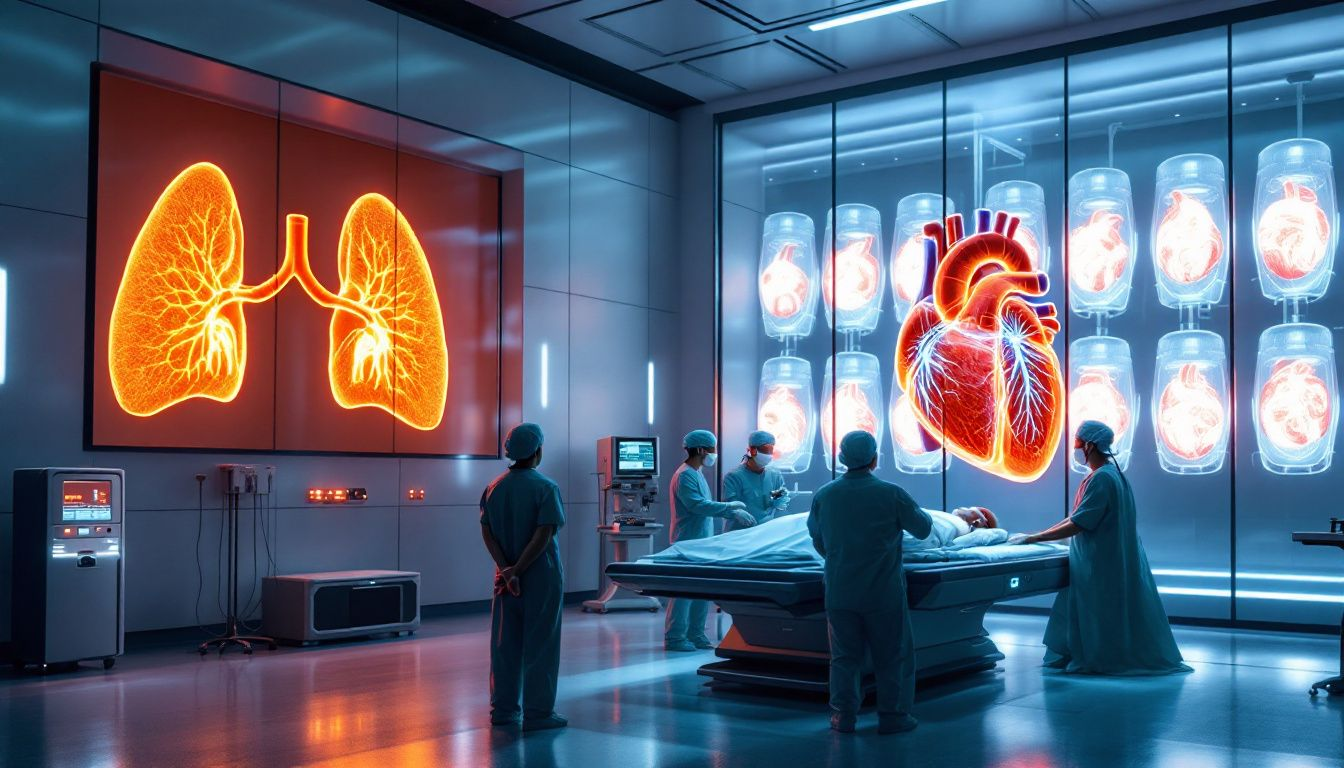Cutting-Edge Advances in Cooling Methods for Organ Transport
Advances in cooling methods for organ transport are transforming organ transplantation. Innovations like hypothermic machine perfusion and supercooling are improving the viability of donor organs during transport. This article explores these cutting-edge advancements, showing how they extend organ preservation times and enhance transplant success.
Key Takeaways
Advancements in organ preservation methods are crucial for improving transplant outcomes and expanding the availability of suitable donor organs.
Innovative techniques like Hypothermic Machine Perfusion and Supercooling significantly enhance organ viability during transport, reducing risks associated with traditional cooling methods.
Future research in organ preservation is focusing on gene therapy and biotechnology to further enhance donor organ resilience and improve transplantation success rates.
The Importance of Organ Preservation in Transplantation

Organ preservation is the cornerstone of successful transplantation. It ensures that donor organs function properly after being transferred, playing a pivotal role in the overall success of the procedure. Without effective solid organ preservation, the risk of graft failure and delayed graft function (DGF) increases significantly, jeopardizing the health and survival of transplant recipients.
Cooling techniques are crucial for organ preservation because they slow down biological deterioration. Lowering the organ’s temperature reduces metabolic rates and cellular activity, effectively placing the organ in a state of suspended animation. This is vital for maintaining organ viability during transport from donor to recipient.
Good preservation significantly impacts graft outcomes. When an organ is re-vascularized—reconnected to the recipient’s blood supply—its functionality is directly linked to how well it was preserved. Effective methods minimize tissue injury and cell death, resulting in better graft survival and overall patient outcomes.
Preservation methods also provide valuable time for the logistics of organ transplantation. Coordinating the retrieval, transportation, and transplantation of donor organs demands meticulous planning. Extending the organs’ viable period allows for necessary preparations, such as matching the organ to the recipient, transporting it, and ensuring transplant teams are ready for surgery.
In organ transplantation, every second counts. Advances in preservation methods enhance the chances of successful transplants and expand the pool of viable donor organs. This is crucial given the growing demand for transplants and the limited availability of suitable organs. Improved preservation techniques ensure more patients receive the life-saving transplants they need.
Traditional Cooling Methods and Their Limitations
Static cold storage (SCS) has long been the most common method for clinical liver preservation. This technique involves flushing the organ with a cold preservation solution and storing it in ice at around 4 °C. While SCS is simple and cost-effective, it has several limitations that have led to the development of more advanced preservation techniques.
A primary limitation of SCS is its reduced effectiveness for extended criteria donors (ECD) and donation after circulatory death (DCD). These donor organs are more susceptible to cold ischemic injury, which occurs when deprived of blood and oxygen at low temperatures. Consequently, SCS is less optimal for these donors, necessitating better preservation methods.
Traditional cooling methods like SCS are also less effective for long durations and distances. The gradual depletion of energy substrates and accumulation of metabolic waste during cold storage lead to a loss of cellular metabolism and cell viability over time. This makes it challenging to preserve organs for extended periods or transport them over long distances without compromising functionality.
Cold ischemic time (CIT) is a critical factor in organ preservation, directly linked to increased risks of graft failure and delayed graft function (DGF). For every additional six hours of cold ischemia, the risk of DGF increases by 23%. This highlights the need for methods that can maintain organ viability for longer periods while minimizing the risks associated with prolonged cold storage.
Despite its limitations, SCS remains widely used due to its simplicity and low cost. However, growing recognition of its drawbacks has spurred research and innovation in organ preservation techniques. The goal is to develop methods that overcome traditional cooling’s limitations and provide better outcomes for transplant recipients.
Innovations in Cold Storage Solutions

The University of Wisconsin (UW) solution revolutionized organ preservation upon its introduction. It significantly improved one-year graft survival rates in kidney transplantation compared to previous solutions. Its ability to reduce delayed graft function and extend cold storage made it the gold standard for renal preservation and kidney preservation in the early 1990s.
The UW solution’s effectiveness lies in its unique composition, including lactobionate, raffinose, adenosine, allopurinol, and reduced glutathione. These components stabilize cell membranes, reduce oxidative stress, and support anaerobic metabolism, improving donor organ preservation. Consequently, the UW solution has become a standard choice in deceased donor transplantation.
Besides the UW solution, other preservation solutions have been developed. HTK solution, for example, is characterized by its low viscosity and plasma-like electrolyte composition. This helps stabilize cell membranes and supports anaerobic metabolism, making it valuable for live donor kidneys.
Celsior solution, initially developed for heart preservation, has also shown promise in preserving other organs. Its key components include high Na+, lactobionate, mannitol, and histidine, which help maintain the functional integrity of organs during cold storage and cold preservation solutions. The inclusion of reduced glutathione as an antioxidant further enhances its effectiveness.
These innovations in cold storage solutions mark significant advancements in organ preservation. By improving donor organs’ stability and viability, these solutions increase the chances of successful transplantation and better patient outcomes. Ongoing research continues to explore new preservation solutions, aiming to further enhance organ preservation and transplantation success.
Hypothermic Machine Perfusion (HMP)
Hypothermic Machine Perfusion (HMP) is a cutting-edge technique that enhances organ preservation by providing continuous perfusion of the organ with a cold preservation solution. One of the key benefits of HMP is that it replenishes ATP, the energy currency of cells, and reduces oxidative stress, thereby improving the viability of the preserved organ.
Adding oxygen during HMP supports ATP synthesis and protects against preservation injury by maintaining the organ at temperatures between 2 and 8 °C. This slows metabolic processes while providing the necessary oxygen to sustain cellular functions, offering a significant advantage over static cold storage methods.
Research has shown that introducing HMP as standard practice in organ preservation leads to better outcomes. For instance, a study in the Netherlands reported a 24% incidence of delayed graft function (DGF) in HMP-preserved kidneys compared to 38% in static cold-storage kidneys. This demonstrates HMP’s potential to reduce risks associated with traditional cooling methods.
Commercial portable HMP systems, like the LifePort Kidney Transporter, Kidney Assist, and WAVES machine, operate within specialized organ transport containers to facilitate HMP in clinical settings. These systems allow real-time assessment of organ viability, providing valuable information on flow and resistance parameters, biomarkers, and imaging technologies. This enables transplant teams to make informed decisions about organ suitability for transplantation.
The future of organ preservation is likely to see an increased adoption of HMP techniques. By combining the benefits of cold storage with continuous perfusion, HMP offers a promising solution to the challenges of organ preservation, ultimately improving the outcomes of transplantation procedures.
Did you know that you can get from Manhattan to JFK in under 5 minutes without driving?
Blade offers seamless helicopter transfers from our West 30th Street Lounge in Manhattan to JFK Airport in just 5 minutes from $195 per seat.
Skip the traffic and ditch the stress with Blade's year-round airport service.

Supercooling Techniques for Extended Preservation

Supercooling techniques represent a groundbreaking advancement in organ preservation, allowing for the storage of organs at sub-zero temperatures without ice formation. By preserving organs at temperatures between -4°C to -10°C, supercooling significantly extends preservation times while maintaining the structural integrity of the organs.
A major benefit of supercooling is reduced cell metabolism, which extends organ storage times. Research has shown that supercooled human livers can be stored effectively for up to 27 hours, significantly increasing the window of opportunity for transplantation. This extended preservation time is crucial for coordinating organ transport and transplantation logistics.
Antifreeze proteins are vital for enhancing the functional outcomes of organs during sub-zero storage. They prevent ice crystallization within cells, reducing the risk of cellular damage. Additionally, cryoprotective agents help maintain a liquid state in cells at sub-zero temperatures, further preventing ice formation and ensuring the viability of preserved organs.
Supercooling has also been shown to improve the preservation of capillary structures in organs, minimizing endothelial damage. This is crucial for maintaining the functional integrity of organs and ensuring successful transplantation outcomes. By preserving delicate vascular structures, supercooling techniques reduce the risk of complications and improve graft survival.
As research in supercooling techniques continues to advance, there is great potential for these methods to become a standard practice in organ preservation. By extending preservation times and improving organ viability, supercooling offers a promising solution to the challenges of organ transport and transplantation.
Normothermic Regional Perfusion (NRP)
Normothermic Regional Perfusion (NRP) is a transformative method that involves perfusing donor organs with warm, oxygenated blood after circulatory death. This technique restores circulation within the donor’s body, significantly reducing cellular injury and extending the window for organ preservation. By maintaining the organs at normal body temperatures, NRP minimizes the damage associated with cold ischemia and enhances the overall quality of the preserved organs.
One of the key benefits of NRP is its ability to extend the time an organ can be used for transplant, thereby increasing organ availability. This is particularly important for donation after circulatory death (DCD) donors, where the time between circulatory arrest and organ retrieval is critical. By restoring circulation and providing oxygen, NRP helps maintain organ viability and reduces the risks associated with ischemic injury.
NRP also allows for functional assessment of organs during the donation process, providing valuable information on their suitability for transplantation. This real-time assessment helps transplant teams make informed decisions, increasing the number of organs that can be successfully transplanted from a single donor. Additionally, NRP reduces the risks of primary non-function (PNF) and improves organ utility in uncontrolled DCD (uDCD) programs.
The NRP technique is typically initiated after a donor’s death is declared, using mechanical devices to circulate oxygenated blood. Thoracoabdominal NRP technology allows for the perfusion of organs at normal body temperatures during collection, further enhancing their preservation. This approach has led to an increase in the average yield of organs from DCD donors, from 1 to 1.4 organs per donor to 3 or more organs.
NRP represents a significant advancement in organ preservation, offering a promising solution to the challenges of organ viability and availability. By combining warm perfusion with real-time functional assessment, NRP enhances the quality and success rates of organ transplants, ultimately improving patient outcomes.
Advances in Lung and Heart Preservation

The preservation of lungs and hearts for transplantation has seen remarkable advancements in recent years. One of the most significant developments is the use of Hypothermic Machine Perfusion (HMP) for lung preservation. This technique provides metabolic support through perfusion, reducing the sensitivity of lungs to hypoxia and improving their viability for transplantation.
Oxygenated HMP has been shown to significantly reduce severe complications and acute rejection episodes in lung transplantation cases. By providing a continuous supply of oxygen and nutrients, this method helps maintain the functional integrity of the lungs and enhances patient outcomes. The use of HMP is a testament to the potential of advanced preservation techniques in improving the quality of donor organs.
For donor hearts, controlled hypothermia methods are employed to maintain temperatures between 4°C and 8°C, minimizing tissue damage compared to traditional ice storage. These methods preserve the heart’s structural and functional integrity, reducing ischemic injury risks and improving the chances of successful transplantation. Controlled hypothermia represents a significant step forward in heart preservation.
The Paragonix SherpaPak cardiac transport system is another notable innovation in heart preservation. This system improves the effectiveness of heart preservation during transport by providing a controlled environment that maintains optimal temperatures and conditions. The SherpaPak system has shown promise as a valuable alternative to traditional methods, offering better outcomes for heart transplant recipients.
Ongoing research and clinical trials continue to explore new methods and technologies for lung and heart preservation. The goal is to further improve the viability and functionality of these vital organs, ensuring that more patients receive successful transplants and enjoy better quality of life. The advancements in lung and heart preservation are a testament to the continuous efforts to push the boundaries of organ transplantation.
Did you know that you can get from Manhattan to JFK in under 5 minutes without driving?
Blade offers seamless helicopter transfers from our West 30th Street Lounge in Manhattan to JFK Airport in just 5 minutes from $195 per seat.
Skip the traffic and ditch the stress with Blade's year-round airport service.

Combining Cooling with Machine Perfusion Strategies
Combining cooling methods with machine perfusion strategies offers a synergistic approach to optimal organ preservation. This integration allows real-time assessment of organ viability and restoration of function prior to transplantation, providing significant advantages over traditional cooling methods alone.
The Hypothermic Oxygenated Perfusion (HOPE) trial demonstrated the benefits of combining cooling with machine perfusion techniques. The trial reported fewer severe complications and a lower risk of liver-related graft loss with machine perfusion, highlighting this approach’s potential to improve transplantation outcomes. By maintaining low temperatures while providing continuous perfusion, this method optimizes the preservation environment for donor organs and extracorporeal membrane oxygenation.
Combining cooling with machine perfusion enhances the assessment of organ viability. The role of AI in organ transport logistics is becoming increasingly significant, as machine perfusion systems provide valuable data on flow and resistance parameters, biomarkers, and imaging technologies, allowing transplant teams to make informed decisions about organ suitability for transplantation. This real-time assessment is critical for ensuring the best possible outcomes for transplant recipients.
The synergy between cooling and perfusion techniques also helps mitigate traditional cooling methods’ limitations. By providing continuous perfusion and oxygenation, normothermic machine perfusion addresses energy substrate depletion and metabolic waste accumulation issues common in static cold storage. This results in better-preserved organs with higher viability for transplantation.
As research and technology continue to advance, the combination of cooling and machine perfusion strategies is expected to play an increasingly important role in organ preservation. This approach not only enhances the quality and viability of donor organs but also expands the possibilities for successful transplantation, ultimately improving patient outcomes and saving more lives.
Future Directions in Organ Cooling Methods

The future of organ cooling methods is poised to see remarkable advancements, incorporating innovative techniques and emerging technologies to further enhance organ preservation. One promising area of research involves the use of gene therapy and targeted pharmacological interventions to improve preservation outcomes. These approaches aim to enhance the resilience of donor organs to ischemic injury and extend their viability for transplantation.
Carbon monoxide has shown potential therapeutic effects during organ transplantation, offering cytoprotection against ischemic injury. However, its use poses some cardiac risks, necessitating further research to optimize its application. Exploring carbon monoxide as a preservation agent highlights ongoing efforts to identify novel solutions to improve organ viability and transplantation success.
Another focus area is the use of growth factors and cytokines to maintain organ viability. These biological agents play a crucial role in cellular repair and regeneration, offering potential benefits for organ preservation. By incorporating growth factors and cytokines into preservation solutions, researchers aim to enhance donor organs’ functional integrity and reduce graft failure risks in ex vivo conditions.
Integrating biotechnology with traditional preservation methods represents a significant step forward in organ cooling techniques. Advances in biotechnology, including new preservation solutions and devices, are expected to extend organs’ viability period and improve transplantation outcomes. This interdisciplinary approach combines existing methods’ strengths with cutting-edge innovations, paving the way for a new era in organ preservation.
As we look to the future, the continuous evolution of organ cooling methods promises to revolutionize the field of transplantation. By embracing these advancements, we can improve the quality and availability of donor organs, ultimately saving more lives and enhancing the well-being of transplant recipients.
Bottom Line: Cutting-Edge Advances in Cooling Methods for Organ Transport
In summary, the advancements in cooling methods for organ transport have significantly improved the outcomes of organ transplantation. From traditional static cold storage to state-of-the-art machine perfusion systems, these techniques have enhanced the viability and functionality of donor organs, ensuring better patient outcomes. The introduction of innovative preservation solutions, such as the University of Wisconsin solution, and cutting-edge techniques like supercooling and Normothermic Regional Perfusion, have further revolutionized the field.
The combination of cooling methods with machine perfusion strategies offers a promising approach to optimal organ preservation. By providing real-time assessment and continuous perfusion, these methods address the limitations of traditional cooling and enhance the quality of preserved organs. As research continues to advance, the future of organ cooling methods looks bright, with the potential to incorporate gene therapy, pharmacological interventions, and biotechnology to further improve preservation outcomes.
The journey of organ preservation is a testament to the relentless pursuit of innovation and excellence in the field of transplantation. By embracing these advancements, we can ensure that more patients receive the life-saving transplants they need, ultimately improving their quality of life and extending their survival. The future of organ preservation holds great promise, and we look forward to the continued progress in this vital area of medicine.
FAQs about Cutting-Edge Advances in Cooling Methods for Organ Transport
Why is organ preservation crucial for transplantation success?
Organ preservation is crucial for transplantation success as it significantly slows biological deterioration and minimizes tissue injury, thereby ensuring that donor organs maintain their functionality when transplanted.
What are the limitations of traditional cooling methods for organ preservation?
Traditional cooling methods for organ preservation are limited by their ineffectiveness for extended criteria donors, as they can lead to cold ischemic injury and delayed graft function, particularly during long-term preservation. These risks underscore the need for improved preservation techniques.
How does Hypothermic Machine Perfusion (HMP) enhance organ preservation?
Hypothermic Machine Perfusion (HMP) improves organ preservation by replenishing ATP, reducing oxidative stress, and facilitating real-time evaluation of organ viability and function. This method significantly enhances the quality and extendability of preserved organs for transplantation.
What are supercooling techniques, and how do they benefit organ preservation?
Supercooling techniques preserve organs at sub-zero temperatures while preventing ice formation, which significantly extends preservation times and minimizes cell metabolism. This method enhances organ viability for transplantation.
What are the future directions in organ cooling methods?
Future directions in organ cooling methods involve the integration of gene therapy, targeted pharmacological interventions, and advanced biotechnology with traditional techniques to improve organ viability and the success of transplants.
Disclaimer:
Please be aware that the content on this page has been generated by using artificial intelligence language models and may contain errors, inconsistencies, or outdated information. It is provided as-is without any warranties or guarantees of accuracy. We strongly recommend using this content as a starting point for further research. We disclaim any liability for damages or losses resulting from the use or reliance on this content.